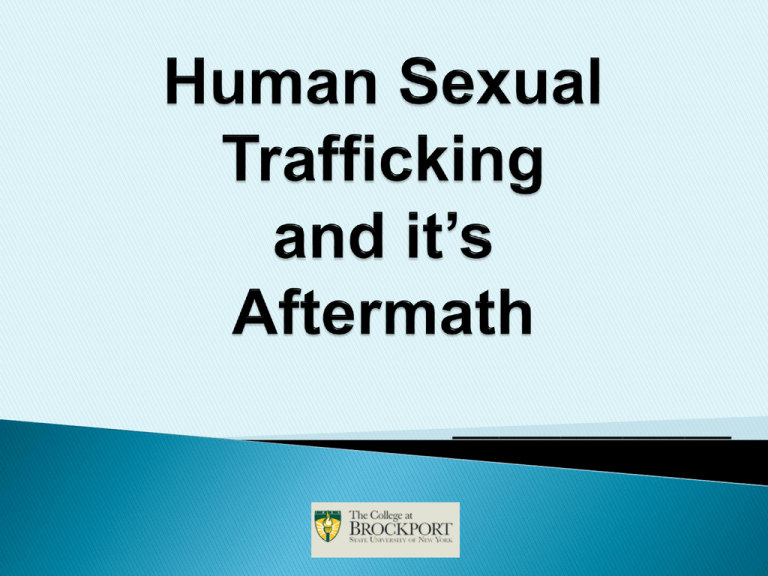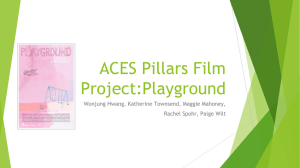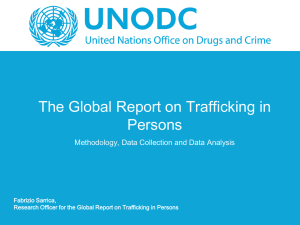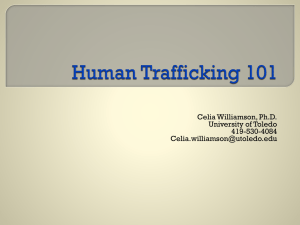
__________________
Presentation- Brief Overview
• Overview
and Definitions
• Background- International and U.S.
• Recovery and Care of Survivors
• Good practices around the world
• Clinical approach in the public health setting
• Ongoing initiatives for prevention
TRAFFICKING
•
Trafficking is the illegal trade in human beings
for the purposes of commercial sexual
exploitation and forced labor
•
Trafficking is consistent with international
definitions and protocols with slavery
UN TRAFFICKING PROTOCOL DEFINES HUMAN
TRAFFICKING AS:
Recruitment, transportation, transfer,
harboring, or receipt of person by
means of threat, force, or other forms
of coercion, fraud, or deception
TRAFFICKING
DEFINITIONS and BACKGROUND
•
The consent of the victim is irrelevant
whenever any of the “means” of trafficking are
used. A child cannot consent.
•
Abuse of a position of vulnerability refers to
any situation where the person involved has no
reasonable or acceptable alternative but to
submit to the person involved.
•
Fastest growing criminal industry in
the world, tied with illegal arms trade
and following the drug trade
•
Revenue may be between USD $5
billion and $9 billion
•
Council of Europe says trafficking has
reached epidemic proportions over the last
decade
•
UN estimates 2.5 billion people are now
trafficked in 127 different countries
•
Statistics may be misleading, total unknown
Trafficking for sexual purposes
•
May be found in dire circumstances and easily
targeted
•
Majority of trafficking is for sexual purposes
•
Homeless, refugees, substance addicted,
runaway teens, displaced homemakers, those in
conflict areas, but victims are exploited from
any ethnic and social background
•
Close connection with pornography, sex
tourism
•
Gender of trafficking for sexual purposes
Girls 80%
•
Boys 20%
Research into gender - based differences in
consequences is incomplete. Preliminary
data has suggested notable differences.
Mongolia:
Trafficking is an emerging phenomenon. Primary targets of
trafficking schemes are young middle class girls and
women, ranging in age from 14 years to the mid-20s. They
are often lured abroad by offers to study or work. Transit
country for trafficking between China & Russia.
Thailand:
Much of cross-border trafficking in SEA involves Thailand.
Burmese children make up the largest number of trafficked
children into Thailand. Trafficking of boys into the fishing
industry in the South is rife and unchecked.
China
Women from Myanmar, Lao PDR, North Korea,
Vietnam and Russia are trafficked to China for the purposes
of prostitution or are forcibly married to Chinese men.
Chinese women are also trafficked to other countries such
as Malaysia, Burma, Taiwan, and Australia.
Japan
Many women are trafficked to Japan for work
in the sex industry, from countries as varied as the
Philippines, Taiwan, Cambodia, Hong Kong, Thailand, Costa
Rica, Sri Lanka, Ukraine and Russia. Reported that a
significant number are under 18 years of age
Trafficking Patterns
in the U.S.
•
ECPAT International
U.S. one of largest producers, distributors, and
consumers of child pornography
•
Source country for child sex tourism
•
Vast majority of sexually exploited children are
stigmatized and trivialized by law enforcement
system. Victims often treated as offenders and
not victims
•
Convention on the Rights of the Child (CRC) not
yet ratified in U.S.- only one of two countries who
have not done so (other country- Somalia)
TRAFFICKING
Children- Commercial Sexual Exploitation of Children (CSEC)
Severe forms of trafficking includes any
commercial sex act performed by a
person under the age of 18. Any minor
who is commercially sexually exploited is
defined as a trafficking victim, whether or
not movement has taken place.
Of the 45,000 to 50,000 victims that are brought to the U.S.A.:
•
30,000 come from Asia- primary countries are
China, Thailand, and Vietnam
•
10,000 from Latin America
•
5,000 from other countries, including the
former Soviet Union, Romania, Africa
•
14,500 to 17,500 are children
TRAFFICKING
Children- Commercial Sexual Exploitation of Children (CSEC)
“…as many as 300,000 American youth may be at risk
of commercial sexual exploitation at any time.
Especially vulnerable are homeless and runaways.”
Univ. of Pennsylvania, 2001, School of Social Work Study
Nationally 450,000 children run away from
home each year. 1 out of every 3 teens
on the street will be lured toward
prostitution within 48 hours of leaving
home. Statistically, this means at least
150,000 children lured into prostitution
each year.
TRAFFICKING
USA
•
•
•
•
•
Miami Fl
Portland OR
Las Vegas NV
Toledo OH
Houston, TX
•
Federal Crime- penalties up to life
•
Cases of human trafficking in all 50
states
•
Children, adults, U.S. or foreign
nationals, male or female
•
Advocacy and specialized agencies to
care for victims is increasing
AFTERMATH OF HUMAN
TRAFFICKING FOR
SEXUAL PURPOSES ON
VICTIMS AND THEIR
FAMILIES
Common experiences of victims
•
Physical and emotional trauma
•
Prolonged Humiliation
•
Violence
•
Degradation
•
Unrelenting fear and abuse
•
Profound violation of human rights
Consequences:
•
Commercial sexual exploitation is the most damaging form
of abuse because it includes almost all forms of abuse-
Physical
Sexual
Psychological
•
Incorporates elements of many crimes including
kidnapping, assault, battery, and others on a daily basis
Associated factors that may increase vulnerability:
•
Relationship with early environment
•
Child and family risk factors- dysfunction, etc.
•
Extreme poverty
•
Gender inequality
•
Substance abuse
•
Myths
•
Community attitudes
All contribute to vulnerability
Consequences
•
Educational deprivation and deficits
•
Physical health problems- health, diet, beatings,
lack of .. inter alia.. health care, hearing, vision,
HIV/AIDs, tuberculosis, STD’s, skin infections,
dental, etc.
Emotional
•
Relationship with families
•
Depression, hopelessness
•
Guilt, shame, flashbacks
•
Nightmares, loss of confidence, self-esteem
•
Anxiety, relationships, behavioral problems,
assertiveness
•
Consequences
Behavioral
attachment
mistrust of adults
sexualized behaviors
antisocial behaviors
Essential Components of Comprehensive Care
•
Safety and security- including implementing all
elements of a “
”
•
Case management- multidisciplinary
•
Legal services
Essential Components of Comprehensive Care
•
Access to appropriate referrals- law
enforcement, medical, psychiatric, etc.
•
Trained staff- essential element, often requires
outside training opportunities
•
Establish basic trust
Essential Components of Care – International
•
Emergency shelters
•
Transit Centers
•
Short term shelters
•
Long term shelters
Caring for Victims
•
Medical Care
Appropriate physical exams
Basic blood work
HIV/AIDS and STD
•
Treatment for substance abuse
•
GYN exams as appropriate
•
Nutrition, hygiene, dental
•
Referrals for complex medical needs
•
•
Vocational Training
•
Basic reading, writing, and numeracy
•
Business skills
•
Formal primary, secondary, and postsecondary education
•
Collectives, self-generating incomes
Caring for Victims
Educational Services
•
Preparation and attainment of competency skills
to integrate into educational system
•
Remedial education and Accelerated Learning
Programs (ALP)
•
Inclusive learning for physical or intellectually
challenged
Caring for Victims
Educational Services
•
Preparation for state examinations, high school and
college entry exams, or skills required for trade
schools
•
Ability to detect learning disorders and provide
available referrals and resources
Caring for Victims
Psychosocial care
•
Controversy exists about individualized therapy
•
Family and community liaison where possible
•
Integration of community-centered approaches
•
Group supportive, solution - oriented therapy
Essential Components of Caring for Victims
Psychosocial care
•
Preparation for re-integration
•
Cognitive restructuring and reframing- move
to multi-dimensional self identification
•
Opportunities for accessing local traditions,
customs, and beliefs
Caring for Victims
Psychosocial care
•
Mental health referrals available for
severe pathology
•
Life Skills training – now seen as an
integral component
Caring for Victims
Psychosocial care
•
Support healthy defenses, explore and support
hidden skills and talents
•
Integrate spiritual beliefs and traditional
healing practices
•
Problem – solving skills
•
Family counseling and therapy
Caring for Victims
Barriers
•
•
•
•
•
•
Community attitudes and beliefs
Pre-existing family dysfunction
Relapse common
Weak law enforcement
Blaming the victim
Severe emotional trauma (often dependent
on age and duration of abuse)
Good Practices and
Programs
International
•
Founded in 1987 and formally registered
in 1989, SANLAAP is a non-government
development organization
•
SANLAAP works to prevent human
trafficking and to prevent secondgeneration prostitution
• .
•
Founded by Indrani Sinha, Sanlaap means “dialogue”
•
Runs four shelters around Kolkata, caring for an average
200 girls
•
Most girls are victims of sexual abuse and trafficking.
•
Large HIV+ population
•
Comprehensive program, including self defense training,
textile shop, bakery, and small contracts for hand-woven
stationery products. This has provided some selfgenerating income
Examples
Sanlaap-India
Examples
Sanlaap-India
•
Integrated into residential communities with no
demarcating signs
•
Counselors trained by volunteers, local NGOs,
and international agencies
•
Teaches girls how to navigate “systems”,
including legal actions, police, social welfare,
and health
•
Encourages advocacy, involved in research
Examples
•
Outreaches to red-light districts to offer
rescue and services
•
Outreaches also are made with the
purpose of learning from sex workers to
plan future interventions based on
current grooming or trafficking trends
Examples
Dhaka Ahsania Mission (Bangladesh)
•
•
•
•
Operates a long term shelter whose primary
objective is to return the victim to social and
family life
Offers trained psychosocial counseling, along
with mandatory literacy and vocational programs
Has local linkages that allow access to microcredit opportunities
Requires an adequate period of family
reintegration counseling before a girl can return
to her community
Examples
Good Samaritan Association
(Addis Ababa, Ethiopia)
•
Long term shelter “Center for Trafficked Women” for
Ethiopian women trafficked abroad
•
Offers psychosocial and vocational counseling and
programming
•
Teaches victims to drive, perform intricate leather work, and
photography
Examples
Movimiento Para el Autodesarrollo Internacional
de la Solidaridad (MAIS) de Puerto Plata
MAIS
DOMINICAN REPUBLIC
Priorities are to help children stay in school,
promote child participation in issues that
concern them,
prevent the abuse and mistreatment of children,
including commercial sexual exploitation.
and
Movimiento Para el Autodesarrollo Internacional
de la Solidaridad (MAIS) de Puerto Plata
Examples
MAIS
DOMINICAN REPUBLIC
•
•
•
•
Provides skills training for heads of families to improve
income
Reduce vulnerability of recruitment
Decrease children’s need to work and that impacts on
school performance
Learning Deficits- ADHD
Examples
Swift Wash: An industrial
laundry as an economic
alternative for victims of
prostitution
Examples
Swift Wash- Goa, India
The goal of the Swift Wash laundry,
launched in 2006, is to provide
support and guidance to former
victims for social integration.
l
Swift Wash- Goa, India
•
Group of former sex workers united to create selfgenerating business
•
Raised funds for laundry machines, dryers, ironing,
steaming, and dry cleaning, vehicles to pick up and deliver,
and advertising
•
Initial group of 200 women obtained support from local and
international NGOs, and now run the company
•
Former sex workers and trafficking victims are hired as
employees
•
Laundry now works 24/7, picks up at home, cleans and irons
at workshop, and delivers clothes back within 24 hours
Examples
Youth Partnership Project
Nepal, Bangladesh, India
•
Survivors of commercial sexual exploitation that
empowers and builds capacity of experiential youth to
take the lead in the fight against CSEC
•
Bangladesh, India, Nepal
•
Peer support projects in high risk areas
•
Trained in media and advocacy skills
•
Peer psychosocial care
•
• Established for the large numbers of children
trafficked in South Asia
Estimates
India 350,000
Nepal 40,000
Bangladesh 29,000
Caring for Victims of Sexual
Trafficking
Clinical and Public Health Settings
Awareness Raising
•
Briefings and sharing information on sexual
trafficking for staff
•
Identification of “red flags” to identify potential
victims
•
Available resources including government and
state agencies
•
Identification of possible referrals
Potential Red Flags:
•
Severe indebtedness with no out
•
Unable to leave a job
•
Inability to leave a situation
•
Isolation from support systems
•
Unaccounted for history, especially if from a
known conflict zone
•
No ID, driver’s license, passport
Potential Red Flags:
•
Adolescents not in school
•
Expensive jewelry or large amounts of cash
•
Cell phones or other items not paid for by
parents or family
•
Has hotel keys
•
Multiple unaccounted for STD’s
•
Inconsistent stories
Potentially More vulnerable (reasonable and balanced approach) :
•
From developing countries where jobs are
scarce
•
Children/teens involved with CPS, foster
care, or criminal justice
•
Severe impoverishment
•
Sudden change in financial status
Management of Victims in Health and Mental Health Settings
•
Consider links to trafficking agencies
•
Victims often do not disclose, or may be very
reluctant to provide details. Often great shame and
guilt
•
Balancing act between clinical symptoms and
respect for privacy
•
Awareness of cultural sensitivities and meanings
Management of Victims in Health and Mental Health Settings
Comprehensive International programs may be instructive:
•
Trust- be aware of own judgments
•
Psychosocial integration with a community
•
Survivor groups, family counseling, individual counseling,
education and skills training, advocacy, cognitive
reshaping, substance abuse treatment
Management of Victims in Health and Mental Health
Settings
Evidence based practices for victims rest on
common components such including PTSD,
non-commercial sexual abuse treatment, and
establishment of an effective and trusting
therapeutic alliance
Management of Victims in Health and Mental Health Settings
PTSD SYMPTOMS
Percentage of PTSD symptoms endorsed by trafficked women:
•
•
•
•
•
•
Recurrent thoughts/memories of terrifying events
Feeling as though the event is happening again
Recurrent nightmares 54%
Feeling detached/withdrawn
60%
Unable to feel emotion 44%
Jumpy, easily startled 67%
75%
52%
Management of Victims in Health and Mental Health Settings
PTSD SYMPTOMS
Percentage of PTSD symptoms endorsed by trafficked women:
•
•
•
•
•
•
•
•
•
•
Difficulty concentrating 52%
Trouble sleeping 67%
Feeling on guard 64%
Feeling irritable, having outbursts of anger 53%
Avoiding activities that remind them of the traumatic or hurtful event
61%
Inability to remember part or most of traumatic or hurtful event 36%
Less interest in daily activities 46%
Feeling as if you didn’t have a future 65%
Avoiding thoughts or feelings associated with the traumatic events 58%
Sudden emotional or physical reaction when reminded of the most
hurtful or traumatic events (Zimmerman et al., 2006) 65%
Management of Victims in Health and Mental Health Settings
“Complex Trauma”
“a type of trauma that occurs repeatedly and
cumulatively, usually over a period of time and
within specific relationships and contexts”
Management of Victims in Health and Mental Health Settings
“Complex Trauma”
Victims suffering from complex trauma often experience
depression, anxiety, self-hatred, dissociation,
substance abuse, despair, and somatic ailments.
Individuals exposed to this type of trauma are also at
heightened risk for self-destructive and risk-taking
behaviors as well as re-victimization, and tend to
experience difficulty with interpersonal and intimate
relationships
Management of Victims in Health and Mental Health Settings
Most commonly seen disorders in trafficking victims:
•
•
•
•
Anxiety disorders (including PTSD)
Mood disorders
Dissociative disorders
Substance related disorders
Management of Victims in Health and Mental Health Settings
Cognitive Behavioral Therapy
•
Restructuring, guilt, shame, being
responsible for events
•
Realistic assessment of talents,
capacities, and human value
Management of Victims in Health and Mental Health Settings
Group Therapy
•
Provides support, peer influence, and
focuses on relationships
•
Group focuses on relationships,
common issues, and coping skills
Management of Victims in Health and Mental Health Settings
Family Therapy
•
When possible, family therapy would
be the “therapy of choice”
•
Family therapy is more effective when
approached in a traditional social
work framework, meeting many needs
Management of Victims in Health and Mental Health Settings
•
EMDR
Because of research from PTSD
•
Substance abuse- needs to tie event and
consequences, rather than just consequences
•
Mood and anxiety disorders- standard
treatment approaches, but meds and therapy
combined
Please see handout for detailed list of resources
REPORTING:
- Local police
- 24/7 toll free Human Trafficking Resource
Center 1-888-373-7888
- Children- National Center for Missing and
Exploited Children hotline 1-800-THE-LOST
Thank you
Thomas G. Shafer, RN, MA
Psychiatric Counselor
College of Brockport
State University of New York
tshafer@brockport.edu






